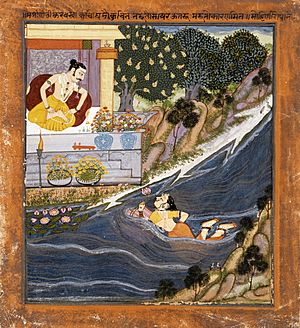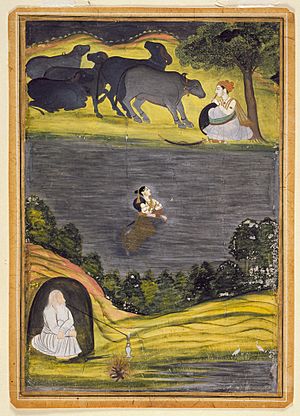Sohni Mahiwal facts for kids
Sohni Mahiwal is a famous and sad love story from the region of Punjab. It's one of four well-known tragic romances from this area. Other popular stories include Sassi Punnun, Mirza Sahiba, and Heer Ranjha. This tale is special because it tells the story from the girl's point of view.
The story is about a girl named Sohni. She was unhappily married to a man she didn't love. Her heart belonged to Mehar, who was a buffalo herder. Every night, Sohni would swim across the river to meet Mehar. She used a special earthenware pot to help her float in the water.
One night, Sohni's sister-in-law found out about her secret meetings. She was very jealous. The sister-in-law secretly replaced Sohni's strong earthenware pot with one made of unbaked clay. When Sohni tried to cross the river that night, the pot made of unbaked clay dissolved in the water. Sohni was caught in the strong river currents and sadly died.
This story is also found in a famous book called Shah Jo Risalo. It's one of seven popular tragic love stories from Sindh, a region next to Punjab. These seven tales are often called the Seven Heroines of Shah Abdul Latif Bhittai, a famous poet. Sohni's story is a favorite folktale in both Sindh and Punjab.
The Characters
Sohni
Sohni was a beautiful and brave young woman. She was known for her deep love and loyalty. Even though she was married to someone else, her heart belonged to Mahiwal. She risked her life every night to be with him.
Mahiwal
Mahiwal, whose real name was Mehar, was a buffalo herder. He was deeply in love with Sohni. He waited for her every night by the river. Their love was so strong that it became a legend.
The Tragic End
The story of Sohni and Mahiwal is a tragedy. It shows how strong love can be, but also how dangerous jealousy can be. The sister-in-law's cruel trick led to Sohni's death. This sad ending makes the story memorable and emotional.
Why This Story is Important
The tale of Sohni Mahiwal is more than just a love story. It is a part of the culture and history of Punjab and Sindh. It teaches about love, sacrifice, and betrayal. People still tell this story today through songs, poems, and plays. It reminds us of the power of true love, even when faced with great challenges.
Images for kids




